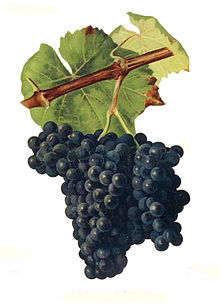| Alicante Bouschet | |
|---|---|
| Grape (Vitis) | |
 Alicante Bouschet in Viala & Vermorel | |
| Color of berry skin | Noir |
| Species | Vitis vinifera |
| Also called | Alicante Henri Bouschet, Garnacha Tintorera |
| Origin | Spain |
| Original pedigree | Petit Bouschet × Grenache |
| Pedigree parent 1 | Petit Bouschet |
| Pedigree parent 2 | Grenache |
| Notable regions | Alentejo, California |
| Hazards | Downy mildew |
| VIVC number | 304 |
Alicante Bouschet or Alicante Henri Bouschet is a wine grape variety that has been widely cultivated since 1866. It is a cross of Petit Bouschet (itself a cross of the very old variety Teinturier du Cher and Aramon) and Grenache.[1] Alicante is a teinturier, a grape with red flesh. It is one of the few teinturier grapes that belong to the Vitis vinifera species. Its deep colour makes it useful for blending with light red wine. It was planted heavily during Prohibition in California for export to the East Coast. Its thick skin made it resistant to rot during the transportation process. The intense red color was also helpful for stretching the wine during prohibition, as it could be diluted without detracting from the appearance. At the turn of the 21st century, Alicante Bouschet was the 12th most planted red wine grape in France with sizable plantings in the Languedoc, Provence and Cognac regions.[2] In 1958, Alicante Bouschet covered 24,168 hectares (mainly across southern France); by 2011, plantings represented less than 4,000 hectares. This scenario is largely reversed in other regions of Europe, and in southern Portugal, where its wines are highly prized and frequently outscore traditional autochthonous varieties.
- ^ Alicante Henri Bouschet Archived 2014-09-10 at the Wayback Machine, Vitis International Variety Catalogue, accessed on June 26, 2010
- ^ J. Robinson (ed) "The Oxford Companion to Wine" Third Edition pg 13 Oxford University Press 2006 ISBN 0-19-860990-6